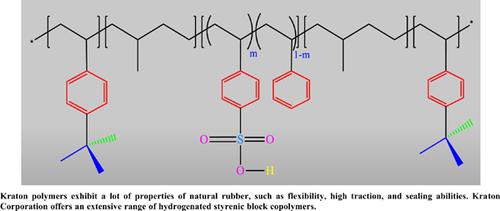Current Analytical Chemistry ( IF 1.7 ) Pub Date : 2021-05-31 , DOI: 10.2174/1573411016666200220114301 Mohd Imran Ahamed 1 , Nimra Shakeel 1 , Naushad Anwar 1 , Lutfullah 1 , Anish Khan 2

|
Background: Kraton/polyaniline ionomer is synthesized and further characterized by electrochemical studies to check the redox properties of the material. Ion exchange capacity, proton conductivity, and selectivity of the synthesized membrane were determined. And found that the membrane was selective for Cu (II) ions.
Methods: The dry Kraton membranes were weighed and kept in 25 mL of 10 % prepared aniline solution in a conical flask for 5, 10, 15, and 20 minutes below 10 0C for socking. The prepared solution of 30 mL of 0.1 M potassium peroxydisulfate was added in a conical flask at constant stirring below 10 0C for half an hour. Finally, the aluminum foil-covered conical flask was kept in the refrigerator for 24 h and modified Kraton membranes were weighed again before carrying out further studies.
Results: The membrane was characterized by some physicochemical methods like SEM, TGA, T-IR, IEC, proton conductivity and selectivity sorption studies. An ionomeric membrane of Kraton polymer was developed as reported earlier. Kraton membrane showed the IEC of 1.9 meq·g-1. The FTIR spectrum of Kraton/PANI film reveals that weight loss up to 400°C may be found because of the thermal degradation of composite substances.
Conclusion: Ion-selective potentiometric was carried out using the self-prepared ion-selective membrane electrode. The membrane was prepared by solution casting method. The membrane was characterized by some physicochemical methods like SEM, TGA, T-IR, IEC, proton conductivity and selectivity sorption studies. On the basis of selectivity studies, the composite material was found selective for Cu (II) ion. A copper ISME was successfully fabricated using the solution casting method. The ISME possessed good selectivity, linearity, working pH range, and response time which was also used as an indicator electrode for the titration of copper using EDTA.
中文翻译:

铜(II)离子选择性膜电极合成Kraton /聚苯胺离聚物复合膜
背景:合成了Kraton /聚苯胺离聚物,并通过电化学研究对其进行了进一步表征,以检查该材料的氧化还原性能。测定了合成膜的离子交换容量,质子传导性和选择性。并发现该膜对Cu(II)离子具有选择性。
方法:称量干燥的Kraton膜并在锥形瓶中的25 mL 10%制备的苯胺溶液中保存,在低于0 0C的温度下放置5分钟,10分钟,15分钟和20分钟以进行缓冲。将所制备的30mL的0.1M过氧二硫酸钾溶液在锥形瓶中在低于0 0 C的恒定搅拌下加入半小时。最后,将覆盖铝箔的锥形瓶在冰箱中放置24小时,并在进行进一步研究之前再次称重改性的Kraton膜。
结果:通过一些物理化学方法对膜进行了表征,例如SEM,TGA,T-IR,IEC,质子电导率和选择性吸附研究。如先前报道,已开发了Kraton聚合物的离聚物膜。Kraton膜的IEC值为1.9 meq·g-1。Kraton / PANI膜的FTIR光谱表明,由于复合物质的热降解,重量损失可能高达400°C。
结论:使用自行制备的离子选择膜电极进行了离子选择电位测定。该膜通过溶液流延法制备。该膜通过一些物理化学方法进行表征,如SEM,TGA,T-IR,IEC,质子传导率和选择性吸附研究。在选择性研究的基础上,发现该复合材料对Cu(II)离子具有选择性。使用溶液浇铸法成功制造了铜制ISME。ISME具有良好的选择性,线性,工作pH范围和响应时间,也可用作使用EDTA滴定铜的指示电极。











































 京公网安备 11010802027423号
京公网安备 11010802027423号